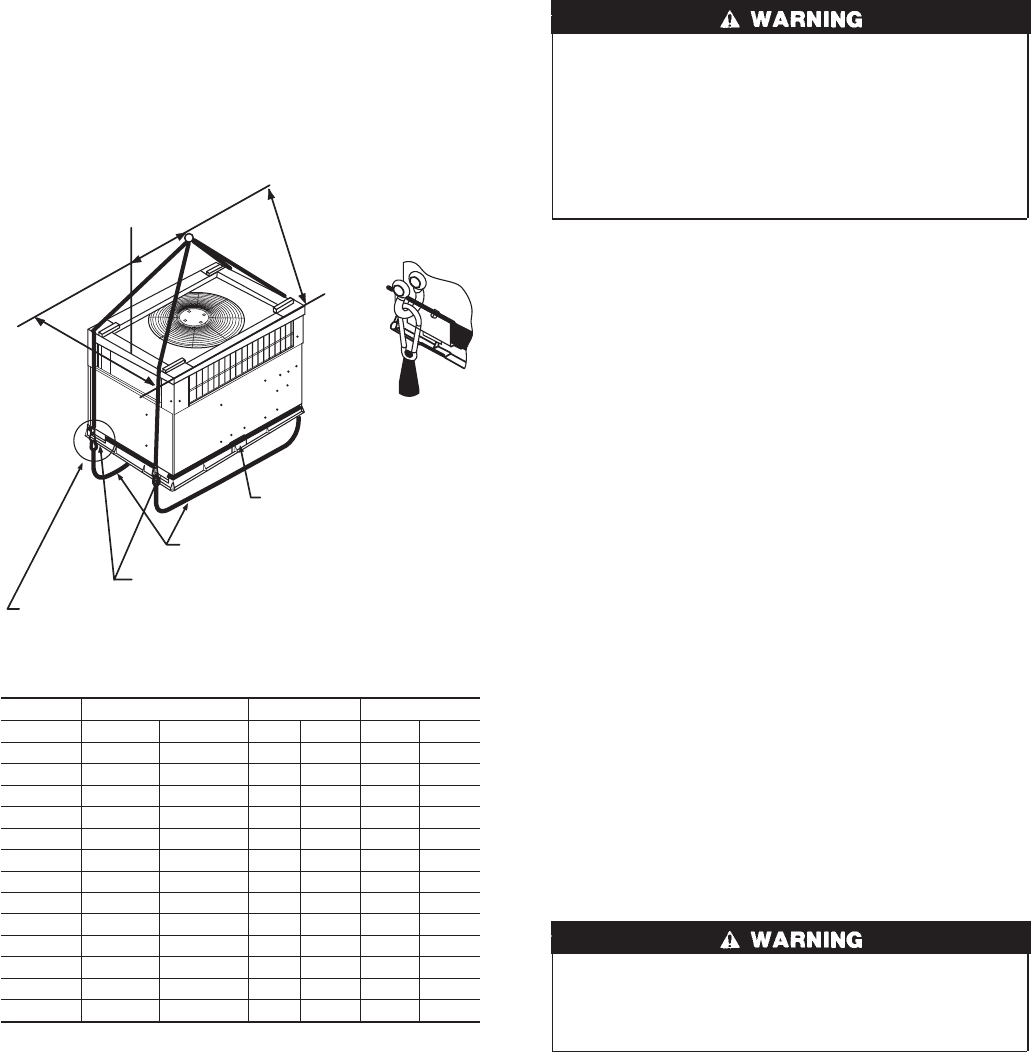
5. Tighten the tension buckle until it is taut. Lifting brackets
must be secure in the handholds.
6. Attach field-supplied clevis or hook of sufficient strength to
hole in the lifting bracket (See Fig. 8).
7. Attach the 2 safety straps directly to the clevis or hook at the
4 rigging brackets. DO NOT attach the safety straps to the
lifting brackets (See Fig. 8).
8. Position lifting point directly over the unit’s center of gravity.
9. Lift unit. When unit is directly over the roof curb, remove the
2 safety straps. Lower the equipment onto the roof curb.
Step 5—Select and Install Ductwork
The design and installation of the duct system must be in
accordance with the standards of the NFPA for installation of
non-residence type air conditioning and ventilating systems, NFPA
90A or residence-type, NFPA 90B and/or local codes and ordi-
nances.
Select and size ductwork, supply-air registers, and return air grilles
according to ASHRAE (American Society of Heating, Refrigera-
tion, and Air Conditioning Engineers) recommendations.
The unit has duct flanges on the supply- and return-air openings on
the side of the unit.
When designing and installing ductwork, consider the following:
For vertical supply and return units, tools or parts could drop
into ductwork and cause serious injury or death. Install a 90
degree turn in the return ductwork between the unit and the
conditioned space. If a 90 degree elbow cannot be installed,
then a grille of sufficient strength and density should be
installed to prevent objects from falling into the conditioned
space. Units with electric heaters require 90 degree elbow in
supply duct.
1. All units should have field-supplied filters or accessory filter
rack installed in the return-air side of the unit. Recommended
sizes for filters are shown in Tables 1A and 1B.
2. Avoid abrupt duct size increases and reductions. Abrupt
change in duct size adversely affects air performance.
IMPORTANT: Use flexible connectors between ductwork and
unit to prevent transmission of vibration. Use suitable gaskets to
ensure weather tight and airtight seal. When electric heat is
installed, use fireproof canvas (or similar heat resistant material)
connector between ductwork and unit discharge connection. If
flexible duct is used, insert a sheet metal sleeve inside duct. Heat
resistant duct connector (or sheet metal sleeve) must extend 24-in.
from electric heater element.
3. Size ductwork for cooling air quantity (cfm). The minimum
air quantity for proper electric heater operation is listed in
Tables 2A and 2B. Heater limit switches may trip at air
quantities below those recommended.
4. Seal, insulate and weatherproof all external ductwork. Seal,
insulate and cover with a vapor barrier all ductwork passing
through conditioned spaces. Follow latest Sheet Metal and Air
Conditioning Contractors National Association (SMACNA)
and Air Conditioning Contractors Association (ACCA) mini-
mum installation standards for residential heating and air
conditioning systems.
5. Secure all ducts to building structure. Flash,weatherproof, and
vibration-isolate duct openings in wall or roof according to
good construction practices.
CONVERTING HORIZONTAL DISCHARGE UNITS TO
DOWNFLOW (VERTICAL) DISCHARGE UNITS
Before performing service or maintenance operations on
system, turn off main power to unit. Turn off accessory heater
power switch if applicable. Electrical shock could cause
serious injury or death.
1. Open all electrical disconnects before starting any service
work.
2. Remove side duct covers to access bottom return and supply
knock outs.
3. Use a screwdriver and hammer to remove the panels in the
bottom of the base pan.
4. Reinstall the side duct covers to block off the horizontal air
openings.
NOTE: These panels are held in place with tabs similar to an
electrical knockout.
NOTE: Avoid abrupt duct size increases and reductions. Abrupt
change in duct size adversely affects air performance.
Step 6—Provide for Condensate Disposal
NOTE: Ensure that condensate-water disposal methods comply
with local codes, restrictions, and practices.
UNIT MAXIMUM WEIGHT A B
Size lb. kg. in. mm. in. mm.
50JS018 305 138.4 19.5 495.3 16.75 425.5
50JS024 311 141.1 18.5 469.9 16.75 425.5
50JS030 309 140.2 19.5 495.3 17.50 444.5
50JS036 313 142.0 19.5 495.3 17.75 450.9
50JS042 345 156.4 19.5 495.3 17.75 450.9
50JS048 375 170.1 20.5 520.7 20.62 523.8
50JS060 440 199.6 19.5 495.3 19.75 501.7
50JX024 321 145.6 19.0 482.6 18.25 463.6
50JX030 342 155.2 20.0 508 19.25 489
50JX036 350 158.8 20.0 508 19.0 482.6
50JX042 372 168.8 21.0 533.4 20.5 520.7
50JX048 377 171.0 20.0 508 21.25 539.8
50JX060 450 204.2 21.0 533.4 20.0 508.0
Fig. 8—Suggested Rigging
C99075
PLACE RIGGING BRACKET ASSEMBLY IN 4
HAND HOLES AND INSTALL TIE DOWN STRAP
AROUND PERIMETER OF UNIT AND THROUGH
SPACE IN BRACKET ASSEMBLY
INSTALL SAFETY STRAPS TO
RIGGING CLEVIS AT 4 RIGGING BRACKETS
TIGHTEN STRAPPING SECURELY
WITH TENSION BUCKLE
SEE DETAIL A
DETAIL A
SCALE 0.250
914-137"
(36"-54")
“A”
“B”
6
